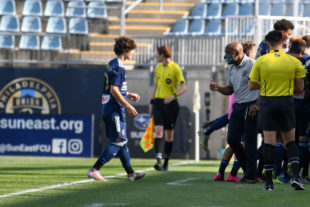Photo: Marjorie Elzey
In his post-opener interview, his pre-Miami press conference, and his after-practice comments on the pitch last Thursday, Philadelphia Union II head coach Marlon LeBlanc mentioned, reinforced, and reiterated his insights on the role of “winning” in Keystone Sports and Entertainment’s player development philosophy.
Player development is where the organization has been investing its money for years. LeBlanc has been overt that the conscious, deliberate emphasis of his coaches and himself is on development not winning. “This is what I think you need to do to become a better, more effective professional player,” might be typical counseling from the coach. He has stated overtly more than once that he and the coaches do not talk a lot about winning.
But he has also said that the adults’ de-emphasis on winning does not mean that winning is not emphasized. The emphasis on winning comes from the players themselves. It comes from the hard-to-pin-down term “culture.”
Both halves of the Union Academy, the academic schoolhouse and the athletic soccer pitch, actively and overtly teach positive self-confidence, enthusiasm, and commitment.
In December 2016, when this writer spent a day “embedded” in the Academy, at 7:45 in the morning the now-retired Ian Munro greeted every player getting off every van with a smile, a handshake, and a cheerfully decisive “Good morning!” Each player answered in kind.
More recently this past Thursday, at the end of Union II practice, two newly signed professionals, striker Nelson Pierre and assistant coach Frazer Johnstone, came over after practice and smilingly fist-bumped the white-bearded stranger in the Australian cowboy hat and his Union II communications companion. It was Ian Munro, all over again.
Six years ago the positive energy in the schoolhouse during late morning school assembly, and in an individual history class, and during what ever variety of science lab I had visited exuded serious, focused curiosity. After lunch in their class on entrepreneurship each of five seniors explained how he was going to take an asset, add value to it, and realize it as a bit of capital to then reinvest in a future project. They reflected closely how the Union organization itself was then planning to do business, as they have now done.
One initial asset was a water-damaged laptop that was going to resuscitated, proven, and sold. Another was a loan for the latest specialized hair-clipper device so that the school’s barber could express the latest fashion in the haircuts of his fellow students – and Richie Graham, the academy’s founder – and earn enough money to repay the loan with some left over to further develop his repertoire.
Early in his time as Union Sporting Director, Earnie Stewart explained the Academy by saying that when he first visited it he immediately noticed the self-confidence of its boys, and, with the enthusiasm a father has for his son, he said emphatically that he wanted that for his boy.
The culture crosses team lines. As reported earlier, the five first-teamers who played for Union II in the season opener played as hard for LeBlanc as they would have for Jim Curtin. Four had come from the Academy so it was second nature, but the fifth, Jesus Bueno, came from Venezuela’s first division last July and celebrated his goal as much as if he had just scored in his national capital.
On his first day back from Argentina at the Thursday practice first-team center back Brandan Craig looked over at his teammates from last season as his own practice drills were beginning, cheering them on while he eased his own soccer-playing muscles towards full functionality.
The organization’s culture and the players themselves take care of wanting to win. LeBlanc and his staff are trusted to tell the boys how to improve themselves so that they can and will do so.
Even though LeBlanc would never be this direct, it is as though he were saying, “Here is how to play better soccer more consistently. Winning will take care of itself because you are already committed to doing so.”


Unfortunately in the world of football, an “academy” is often not a place of learning or seeking truth, but more like a factory than anything else. A far cry from what an academy should be. It’s nice to hear that we have something different in Wayne. A sacred space, maybe. Tim didn’t mention any olive groves but I suspect they would not be out of place there.
I would say this piece showes we,the Union faithful, can de assured that the things that we have collectively been asking for are in place. That the vision,plan,and philosophy of a good organization start with the youth and move forward to the first team! Thanks Tim! Keep up the good work!!
It is a universal bummer… so few soccer opportunitites in America are centered around this philosophy.
.
Sure club-websites can claim ‘possession’ and ‘development’ but the stark reality is because of US Soccer policy which limits access to first divison soccer- thereby artifically hampering development to a first team across 1,000xs of clubs and therefore the development of professional players with real money $$$ over their heads, (instead of $3,000 club fees parents pay for access) we are forced to choke down winning as the metric for success. What’s worse… even these Professional Academies are not in the business of developing professional players. They are there to identify the one or two players per age group who have a ‘pathway in the program’ to a first team and potential sell on….and EVERY other kid there from a soccer perspective is to serve the development of those two players. This is truth. Some may try to argue me. They are wrong. PERIOD. The end.
.
Awesome work as usual Tim.
.
Sincerely,
the Elephant
I’m not sure there is any development system anywhere in the world that does not winnow out the players that aren’t going to make it to some level of professional success. That is fact. Maybe the good academies get more than one or two players from each age group but most players are not going to make it in any real sense. Where to fault the majority of the US development system is not this fact. It is the fact that some still take money from the many players that are never going to make it by saying “one more year and you may have a chance” and in reality they have no chance. That is the travesty of the US system.
We took a player from Miami that they thought had no chance…. The cycle continues at every level but sometimes it’s on the player.
.
I find it fascinating that we always concentrate on the mystical white whale of a player that we think is out there, instead of the ones that are there.
Your point is an interesting one Jack. Is there some measure for allowing kids (or their parents…) a chance to keep giving it a chance? The numbers say they won’t make it in either case, but it they’re already in the winnowed group, does it hurt giving them another year? I wonder what my own choice would have been, had I been good enough but not great. Hard to say.
Two points occur to me as I had just read Jack and John P. O’Donnell.
.
1. After my “embedded” day at the Academy in December of 2016, one of the first articles I wrote predicted that the business plan for the Academy was that it would give virtually all its students, certainly all those who earned a diploma, access to NCAA soccer. And that if the-player were division I quality, access to an athletic scholarship. That, I said, would be why parents might be willing at some future date to pay something to send a male child to the Union’s Academy.
.
I never discussed the story before or after publication with Richie Graham. But as he passed underneath the balcony on which I had been watching a Bethlehem preseason scrimmage a day or two later, he smiled and gave me a hearty thumbs up. It seems I had gotten the essentials more or less correct for how the Academy might become closer to self-sufficient than it was then.
.
2. We need to be unvarnished and truthful and call players who finance their college educations by playing soccer professionals, whatever mythology the NCAA tries to continue to perpetuate.
.
3. I intend to try to focus away from John O’Donnell’s “white whale” and get concrete about Union II’s specific players after they play Crew 2 on Sunday. If I manage to do it decently, it will none the less be a massive, massive piece. I realize fully that little to nothing has been available for nearly a year and a half. Finally we have some games to watch and therefore material from which to work.
.
I do realize that “Philadelphia” uses up twice as many “Ps” as there are in “patience!” 😉
In related news the Gen Adidas tournament begins Saturday for U15 and U17. 40 teams per level, the U15s are in a group with Porto/Portland/Atlanta and U17s are with LAFC/Flamengo/Weston FC. Schedule and info at mlssoccer.
I expect the tournament may edit the players available on Union II’s bench Sunday evening..
.
A Nelson Pierre absence would surprise me. Bajung Darboe’s would not, at all. Frank Westfield’s would only a little.
Union II signed Kleberson as an assistant coach. Not sure what Bendik thinks of this.
Made me smile.
Under Nick S. the academy excellence would have never happened. Herr Tanner, with his global view and knowledge of training young adults to excel, enacted all that we see now, and will into the future.
Mr. Sugerman… I know you generously offered Herr Tanner a 3 year contract extention… Please extend forever.
In the past you personally know my angst at your club NOT focused on winning. Since the brilliant hiring of Herr Tanner never a need for 8 page letters of complaint, huh?
THÀNK YOU for bringing winning to Chester and hosting MLS Cup 2022.
DOOP!